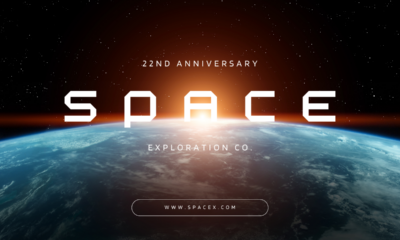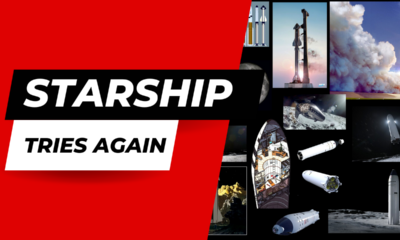News
SpaceX wins FAA launch license for Starship
The Space Exploration Company (SpaceX) won its launch license from the FAA to test its heavy-lift rocket, Starship.

The U.S. Federal Aviation Administration (FAA) has granted a launch license to the Space Exploration Company (SpaceX) to launch its heavy-lift rocket, Starship, from its factory and proving ground near Boca Chica, Texas.
SpaceX go for launch
The FAA announced their long-awaited decision yesterday afternoon (April14).
After a comprehensive license evaluation process, the FAA determined SpaceX met all safety, environmental, policy, payload, airspace integration and financial responsibility requirements.
This decision came after SpaceX agreed to at least seventy “mitigations” at its Boca Chica proving ground. Starship is the heaviest, most powerful rocket ever built, more powerful than even the N1 heavy-lift rocket from the 1960s. The first or booster stage boasts 33 Raptor engines that use liquid methane and liquid oxygen for fuel. Even the Saturn V, that carried six astronaut crews to the Moon and back, does not match Starship. Furthermore, SpaceX has never launched anything from Boca Chica other than Starship’s second stage (also called “Starship” proper). So the FAA heard public comment from environmentalists – and neighbors – worried about the tremendous noise and explosion hazard.
SpaceX has been working on getting ready to launch Starship while waiting for the FAA to act. It will now proceed to launch, no earlier than Monday (April 17). A 150-minute “test window” opens at 7:00 a.m. CDT.
Elon Musk, owner of SpaceX and several other companies, left this pithy tweet on Twitter:
Why success cannot be guaranteed
SpaceX said more on their website, to describe their expectations for this Orbital Flight Test:
With a test such as this, success is measured by how much we can learn, which will inform and improve the probability of success in the future as SpaceX rapidly advances development of Starship.
To succeed completely, the rocket must first lift off without blowing up. Then it must continue to ascend, eventually achieving Max Q, the instant of maximum aerodynamic pressure on the rocket. (Above a certain altitude, the atmosphere thins, so aerodynamic pressure declines even as the rocket gains speed.) Staging – separation of the two stages – must then occur about three minutes into the flight. The booster will then splash down into the Gulf of Mexico, while the second stage continues to orbit. That orbit will carry Starship over the Atlantic Ocean, southern Africa, the Indian Ocean, Australia, and the Pacific Ocean, to a splashdown off Hawaii.
Starship has a rated capacity of 100 metric tons, with a 150-metric-ton version planned. Falcon Nine, which carries most of SpaceX’ payloads, has a capacity of 22.8 metric tons. The 33 Raptor engines will deliver a combined thrust of 16.5 million pounds, or 73.4 meganewtons.
Starship’s mission
SpaceX intends using Starship to carry large racks of satellites for its Starlink low-earth-orbit satellite Internet service. It will also carry satellites from multiple customers, through its “Ride Share” program. The United States Space Force would like to use Starship to deply troops to any point on Earth within hours. Elon Musk has also talked hopefully of supporting scheduled commercial transportation service.
But the real mission of Starship will be to plant a colony on Mars. Hence the “Methalox” (methane-and-oxygen) fuel for the Raptor engines; in theory, colonists on Mars could make methane from Mars’ atmosphere. Musk has always wanted to establish humanity as a “multi-planetary species.” Commentator Jordan “The Angry Astronaut” Wright has repeatedly observed that Martian colonists could support themselves easily by asteroid mining. Of particular interest is Asteroid 16 Psyche, which carries supplies of iron and nickel which could be worth $10 quintillion.
Earlier speculation that 16 Psyche was rich in gold and platinum seems to have fallen out of fashion. But even base metals, in sufficient quantity, could change the economy of Earth. With such a “motherlode,” a Martian city could support its own steel industry and ultimately build its own rocket ships to support commerce with Earth.
Terry A. Hurlbut has been a student of politics, philosophy, and science for more than 35 years. He is a graduate of Yale College and has served as a physician-level laboratory administrator in a 250-bed community hospital. He also is a serious student of the Bible, is conversant in its two primary original languages, and has followed the creation-science movement closely since 1993.
-

 Executive5 days ago
Executive5 days agoThe Hunters Have Now Become The Hunted: Their Cruelties Are Swelling The Ranks Of The People Worldwide!
-

 Clergy4 days ago
Clergy4 days agoWhy Do The American People Let The Corrupt Media & Politicians Set The Propaganda Narrative – Speak On Their Behalf
-

 Constitution5 days ago
Constitution5 days agoCHAPTER 9: Norman Dodd Interview Space Is No Longer the Final Frontier––Reality Is [upcoming release April 2024]
-

 Entertainment Today4 days ago
Entertainment Today4 days agoCivil War (2024) – an incomplete prediction
-
![CHAPTER 10: Objective Reality Is Required for a Free Society Space Is No Longer the Final Frontier—Reality Is [upcoming release May 2024]](https://cnav.news/wp-content/uploads/2024/04/Objective-reality-v-acceptance-400x240.png)
![CHAPTER 10: Objective Reality Is Required for a Free Society Space Is No Longer the Final Frontier—Reality Is [upcoming release May 2024]](https://cnav.news/wp-content/uploads/2024/04/Objective-reality-v-acceptance-80x80.png) Education4 days ago
Education4 days agoCHAPTER 10: Objective Reality Is Required for a Free Society Space Is No Longer the Final Frontier—Reality Is [upcoming release May 2024]
-

 Human Interest3 days ago
Human Interest3 days agoIdaho prepares to defend its abortion ban
-

 Civilization3 days ago
Civilization3 days agoEarth Day Should Celebrate U.S. Progress & Innovation
-

 Civilization1 day ago
Civilization1 day agoNewsom plays silly abortion politics














